Moment of inertia Ix for the Trapezium.
1-For the moment of inertia Ix for the trapezium, it can be obtained by considering the trapezium as consisting of one big rectangle, from which two triangles are subtracted as shown in the following slide.
The Trapezium with base b and the upper top side a and height h, is divided into the following shapes:
1- A rectangle of base b and a height of h, its area A1=b*h, it is CG is apart from the y-axis by a distance x1= (b1+0.50*a).
2-A left triangle of base b1 and a height of h, its area A2=1/2*b1*h, it is CG is apart from the y-axis by a distance x2=(2/3*b1).
3-A right triangle of base b2 and a height of h, its area A3=1/2*b2*h, it is CG is apart from the y-axis by a distance x3=(b1+1/3*b1).
The area of the trapezium is the area of the rectangle-Area of the left triangle- and the area of the right triangle.
The details of these shapes are shown in the next slide images.
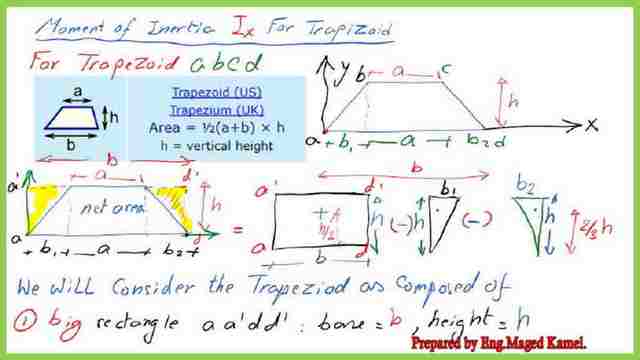

The value of Ix for the rectangle.-Ix for the rectangle =b*h^3/3.
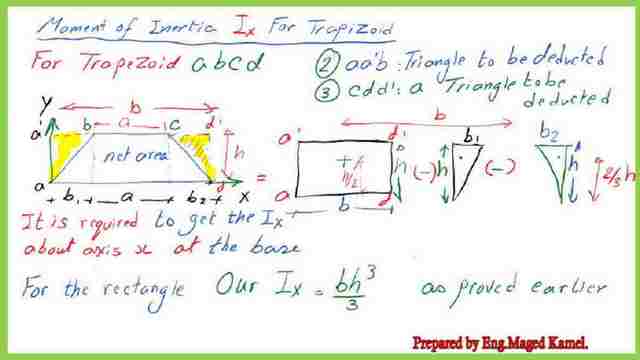

The moment of inertia Ix for the upper left triangle at the x-axis at the base of the trapezium is to be obtained by adding (A*y^2 bar) to the moment of inertia about the Cg for that right-angle triangle, Ixg of that triangle.
The y-bar =(2/3)h, where h is the height of the triangle and the same for a triangle.
Adding the two figures together will bring to us the final value for that triangle 4- While for the Ix for the upper right triangle at the x-axis, to be obtained by adding (A*y^2 bar) to Ixg of that triangle. This is the final value of Ix for the triangle at the left edge.
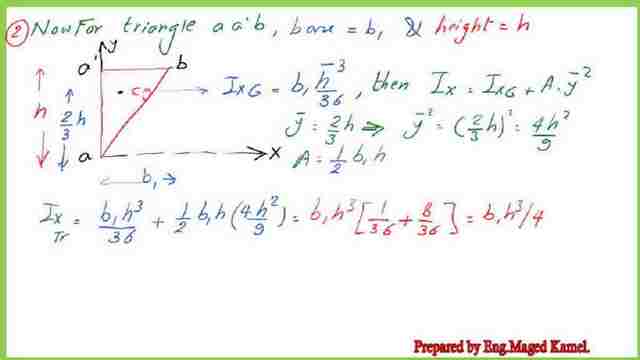

The Ix final value is estimated as Ix for the rectangle -Ix for the left triangle- Ix for the top – right (tr)triangle.
Ix for the trapezium is the ix value for the rectangle minus the sum of inertia for two triangles.
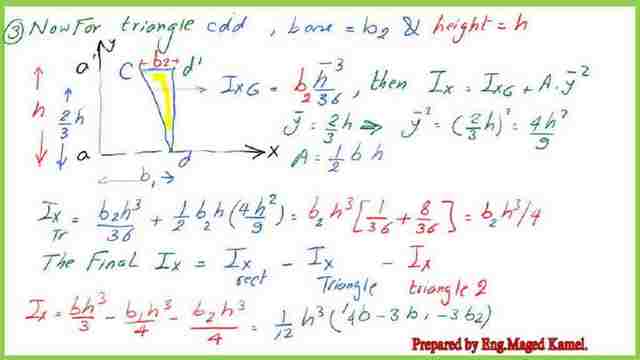

Finally, the Ix for the trapezium can be obtained as the summation of the three inertias, and consider that we deduct the two inertia values of the two triangles, so we put a minus sign.
This is the final value for Ix for the trapezium, where the x-axis is passing by the base.
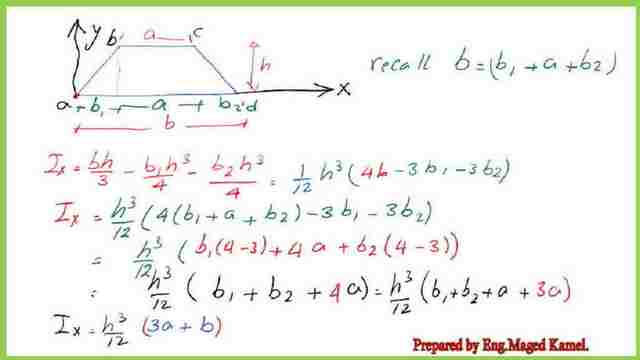

We can convert the trapezium into a triangle by omitting the value a, so we can get the expression for Ix for a triangle as shown in the next slide. In that case the final value of Ix for the triangle =h^3/12*(b1+b2).
Again if we consider b1=b2=0, we will get Ix= h^3*(3*a+(0+a+0)/12)=a*h^3/3, which is the Ix for a rectangle at the base. Check the case when a=0, what will be the value of Ix?
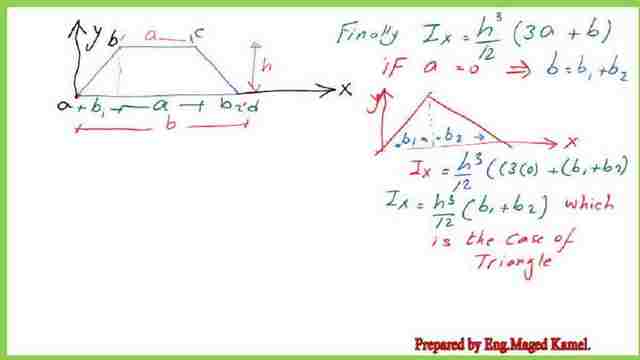

Moment of inertia Ix for the trapezium at The CG.
Ix at the Cg of the trapezium can be obtained by using the parallel axes theorem, by subtracting(Ay-bar^2) from the Ix of the trapezoid. A is the area of the trapezium, Y bar value=((h/3)(2a+b)/(a+b)).


Step-by-step procedures to get the final Ix value as shown in the next pictures. The related calculations for ix at the centroid for the trapezium.
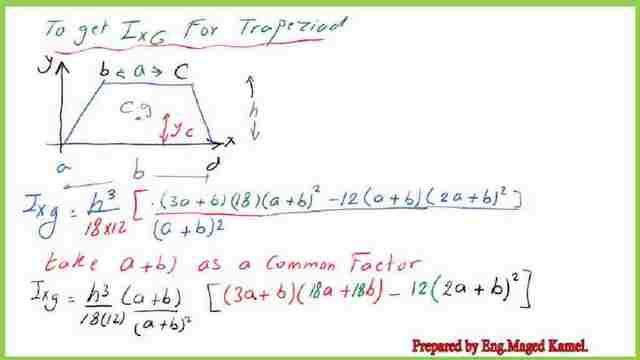

We simplify the expression by adjusting similar terms. Adjusting the various terms for ix at the Cg for the Trapezium.
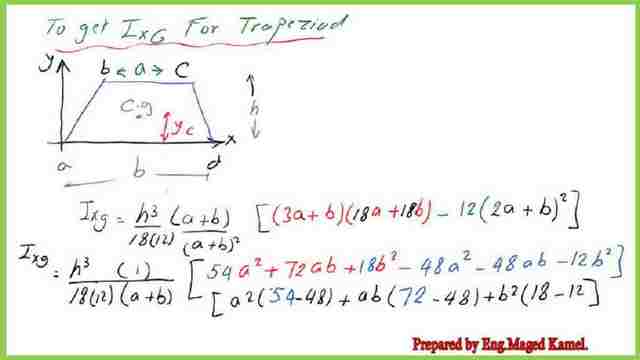

Finally, the Ix for the trapezium value for Trapezium at the Cg can be written as shown in the next slide image. together with ix for the trapezium about an x-axis at the base.
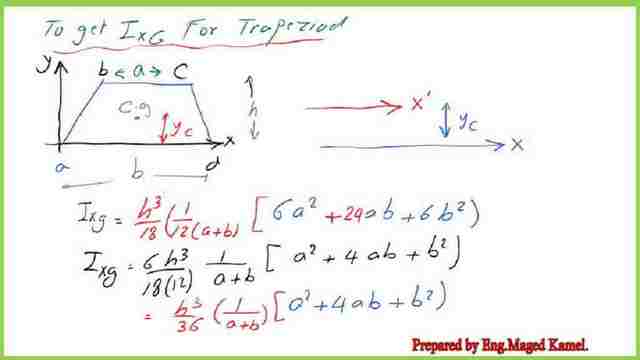

The radius of gyration rx for the trapezium at the x-axis.
The square of rx, at an external axis that passes at the base of the trapezium, can be obtained by using the expression of Ix=A*rx^2, we have the area=0.50*(a+b)*h, so we can get the square radius of gyration about the x-axis by dividing Ix/A and trapezium area.
The final expression is shown in the next slide image, The value of rx^2 matches the value shown in the FE reference handbook.


The radius of gyration rx g for the trapezium at x’-axis passing by the CG.
the radius of gyration rx at the x’-axis passing by the Cg can be obtained by using the expression of Ixcg =A*rxg^2, we have the area=0.50*(a+b)*h, so we can get the square of the radius of gyration about X’-axis passing by the CG by dividing Ixg/A and trapezium. The expression is given in r^2x.


The final expression is shown in the next slide image. The value of rxg^2 matches the value shown in the FE reference handbook.
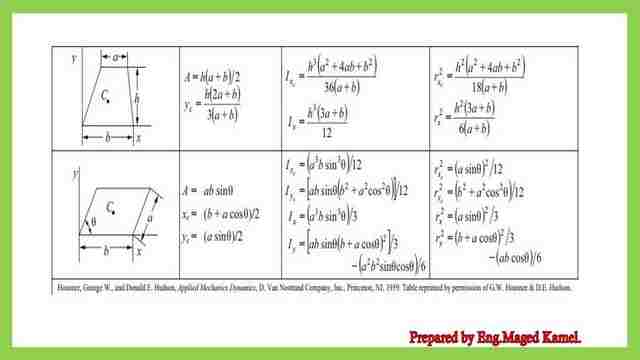

This is the pdf file used in the illustration of this post.
Please refer to post 24– for Ix option 2 for the trapezium. how to use a horizontal strip to get the Ix value?
Please refer to post 22 for the moment of inertia Iy for the Trapezium.
For practice problems, please refer to posts 25 and 26.
For the use of a calculator for various shapes, please find Moments of Inertia – Reference Table.
This is a link to the complete details of how to get an x-bar and y-bar for a Trapezium.
This is the next post-Ix for a parallelogram.

